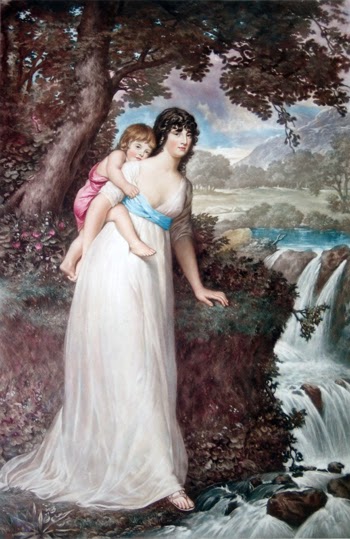Non
conformists in matters of religion were often conventional when it came to
anything else. The desire not to stand out in a crowd is evident in the rows of
plain headstones of almost identical proportions that mark the graves of
Bunhill Fields where ostentation and ornamentation were obviously frowned upon and there are few large tombs or monuments. Merchant
banker Joseph Denison’s grand neo-classical, Portland stone pedestal tomb suggests
that he had a streak of worldly pride that trumped the desire to remain inconspicuous. There is some obscurity about his origins but
we know that he came from Leeds, was born in the mid 1720’s and was probably
from a mercantile background. Accounts of his life which claim that he was a
“parish boy ignorant of reading and writing who made his way from Yorkshire up
on foot” are unlikely to be true considering that once in London he became a clerk in the counting house of Mr Dillon an Irish Catholic
merchant (whose business eventually failed forcing him, in one of those neat
reversals of fortune usually only found in fiction, to take a job in the
counting house of his former clerk Joseph Denison whose career was, and
remained, in the ascendant). “At length he entered into business for himself,”
says Dodsley’s Annual Register, summing up his life in the year of his death,
1806,”and by unabated industry and the most rigid frugality, worked himself
into very high credit, and an increasing fortune.” As well as his house in
London he bought, in 1787 the estate of Denbies in Surrey once owned by
Jonathan Tyers, and in 1782, from the Duke of Leeds for the huge sum of £100,000
the east Yorkshire estate of Seamere near Scarborough.
Joseph
Denison married twice, his first wife, Sarah Sykes was from Salford and,
according to Dodsley’s, “very assistant to his prosperity,” helping with his
bookkeeping and looking after his affairs when he travelled away on business.
Sarah died young and the marriage was childless. His second marriage, to Elizabeth Butler of
Southwark, was even shorter. After a mere three years of matrimony, during which
she produced three children, a son and
two daughters, Elizabeth died in 1771 at the age of 32 leaving her young family
to be brought up by their father.
Portrait of Elizabeth Denison-Conyngham with her eldest child.
Joseph’s
son William Joseph, became the senior
partner in his father’s business and an MP. In business he was extraordinarily
successful leaving an estate worth £2.3 million to his nephew when he died in
1849. Anna Maria his youngest daughter made a decent marriage to Sir Robert
Lawley, later 1st Baron Wenlock. His eldest daughter Elizabeth
married an Irish peer Henry Conyngham, Viscount Conyngham, in 1794. By all
accounts an attractive woman in her youth, Elizabeth had a number of admirers
and lovers including the then Tsarevitch
of Russia, the future Nicholas 1. Her
greatest and most famous conquest though was of the notorious philanderer
George IV. Lady Conyngham supplanted
Lady Hertford in the King’s affections in 1820 and she more or less lived
openly with him as his unofficial queen (with her real husband made Lord Steward
of the Kings Household and promoted to Marquess as reward for his complaisance)
until his death in 1830. The obese King was apparently besotted with his equally
rotund 50 year old (and mother of five) mistress and would be constantly
"kissing her hand with a look of most devoted submission.” During the
Kings Coronation when his rightful Queen, Caroline of Brunswick was denied admission
to Westminster Abbey turned away from the door by the Royal Guards, George made
himself ludicrous by ‘nodding and winking… and sighing and making eyes’ at Lady
Conyngham. She lived with him at the Royal Pavilion in Brighton where George
developed chronic alcoholism and left his mistress looking “bored to death and
never speaking” at interminable formal dinners according to Charles Greveille.
"The guard wot looks after the sovereign" - Lady Conyngham as the butt (of all jokes)
The Kings disrespectful subjects found an endless source of mirth in the
ridiculous figures of two overweight elderly people apparently being in love:
‘Tis pleasant at
seasons to see how they sit,
First cracking their nuts, and then cracking
their wit,Then quaffing their claret - then mingling their lips,
Or tickling the fat about each other’s hips.
and another example:
He’ll never need pillows to keep up his head,
Whilst old Q and himself sleep and snore in one bed.
When
George died in 1830, The Times declared that ‘there was never an individual
less regretted of his fellow creatures than the late king’. Henry Conyngham
died in 1832 in Kent, alone again as Lady Conyngham had moved discretely to
Paris where she lived for the next thirty years. She only returnined to England
to die at the age of 92 and be buried
with her husband in Kent at St Mary's, Patrixbourne.
Sources:
Dictionary of National Biography
Dodsley's Annual Register Volume 48
George IV's Royal Visit to Ireland
Sources:
Dictionary of National Biography



The Denisons. Deplatformed in their time! By The Rothschilds! Overnight, could issue personal cheques! The Rochschilds paid of Queen Victoria's French wars debt!
ReplyDeleteCorrection! where barred from issuing personal cheques!As I said deplatformed in 'The Time'!Rothschilds to the rescue! Ah, but there was a clause in there.Denison Beckitt bank deplatformed!
ReplyDeleteThe unclaimed money of The Bank of England! We are working on it!
ReplyDelete